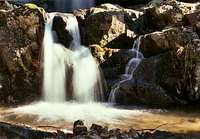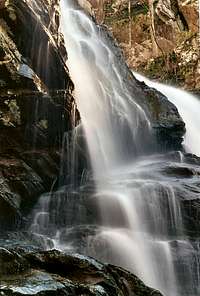-
 10047 Hits
10047 Hits
-
 76.66% Score
76.66% Score
-
 7 Votes
7 Votes
|
|
Canyon |
|---|---|
|
|
38.24440°N / 78.6865°W |
|
|
Hiking, Scrambling |
|
|
Spring, Summer, Fall, Winter |
|
|
Overview
The canyons of Doyles River and Jones Run contain some of Shenandoah’s most spectacular woodland and water scenery. Waterfalls are the scenic highlights of the canyons, but the canyons are also excellent places to see immense trees, abundant wildflowers (March through November), dozens of small cataracts and crystal-clear pools, and the colorful foliage that draws thousands of visitors to the Blue Ridge on October weekends (hint—to avoid the crowds but still enjoy the colors, visit in early November, when there is usually still plenty of nice color but the crowds are gone). There are also numerous rock outcrops that can provide much scrambling and bouldering fun for children and adults alike.
Doyles is the steeper of the two gorges and probably the more dramatic. It narrows considerably at times, revealing sheer cliffs and giving the feel of a wild mountain canyon. There are two main waterfalls along the trail, the lower one being the higher at 63’ and falling in two steps between high cliffs (the upper is 28’ and falls in three steps in a more-open setting). Standing at the base of the upper falls during a period of high runoff, though, you will think that for the force and the roar of the water, the falls are much higher. In such conditions, it is one of the park’s most impressive waterfalls.
Another nice thing about Doyles River and Jones Run is that although neither is a secret and both are quite popular, being in the South District (which sees less visitation and trail use than the park’s other two districts do), their trails are not nearly as busy as those in other well-known waterfall areas such as Dark Hollow Falls and Whiteoak Canyon.
A good trail runs through the canyon and connects with the Jones Run Trail, the Appalachian Trail (AT) and the Browns Gap Fire Road to form loops that many, if not most, visitors to these streams follow. The trail is pretty steep, though, dropping about 1400’ in 2.2 miles to its junction with the Jones Run Trail, where the streams merge. The longer loop is nearly twice as long as just hiking down and back out, but the shorter loop really is not that much longer and harder than the down-and-back option. It’s almost foolish not to hike the loop; the extra scenery is more than worth the extra effort. Note: if one is hiking the shorter loop, he or she should begin from the Jones Run Trailhead, not the one for Doyles River.
Loop Details (from Doyles River Parking Area at 2870’)—
• 0.3 miles: Spur trail goes 0.1 mi uphill to Doyles River Cabin.
• 0.9: Browns Gap Fire Road (keep going straight).
• 1.2: Upper falls. A short spur provides very easy access.
• 1.5: Lower falls. Good views from the trail, but the best views come after steep scrambling and bushwhacking to the base. Look for and use social trails, and watch your footing; it can be extremely slippery here.
• 2.2: Confluence with Jones Run and intersection with Jones Run Trail at 1500’.
• 2.7-3.0: Lower and upper falls on Jones Run.
• 4.7: Jones Run Parking Area and intersection with the AT. Follow the AT north.
• 5.9: Browns Gap Fire Road. Stay on the AT.
• 8.1: Doyles River Parking Area.
Getting There
Enter Shenandoah National Park’s Skyline Drive at any of its four access entrance stations and drive to the Doyles River Parking Area at MP 81.1 (do not confuse this with the Doyles River Overlook, which is a little farther south, though it does access the AT between the two canyons). This requires driving SOUTH unless you enter at Rockfish Gap.Red Tape
It costs $15 to enter the park, and that provides access for a week. Annual passes cost $30. The interagency pass, good for yearlong entry to areas managed by NPS, USDA Forest Service, USFWS, BLM, and the Bureau of Reclamation, costs $80.The park is open all year, but Skyline Drive does sometimes close after snow or ice storms. The park site does not give current road conditions, so call ahead (540-999-3500).
To reduce poaching, Skyline Drive is subject to closures during hunting season. The information below, copied and pasted from the park site, illustrates the 2006 restrictions—
From November 13, 2006, through January 6, 2007
Skyline Drive
• between Front Royal (Mile 0 at U.S. Highway 340) and Thornton Gap (Mile 31 at U.S. Highway 211), and
• between Swift Run Gap (Mile 65 at U.S. Highway 33) and Rockfish Gap (Mile 105 at U.S. Highway 250),
will be closed daily between 5:00 p.m. and 8:00 a.m.
The central portion of the Drive, between Thornton Gap and Swift Run Gap, will remain open for overnight access to Skyland Resort and Big Meadows Campground until those facilities close on November 26.
Then, beginning November 27, 2006, through January 6, 2007, the entire length of the Skyline Drive will be closed daily from 5:00 p.m. until 8:00 a.m.
Shenandoah is black bear country. Store food properly. Backcountry bears are rarely a problem, but observe backcountry etiquette as diligently as you would (or should) the rules of developed campgrounds.
Camping
The closest campground is Loft Mountain, which has showers, water, flush toilets, and a store. The access road for the campground is at MP 79.5. The campground is open from mid-May through October, and you can make reservations to stay there, though only 10% of the sites are reservable (see park link for more details). It is the park’s largest campground, but it will usually fill on holiday and October weekends. The fee for a campsite is $15 per night (as of 2007, higher if you reserve).Backcountry camping is free (no fires allowed), but a permit is required. Permits are available at entrance stations and ranger stations and can often be done in self-serve style.
The Potomac Appalachian Trail Club (PATC) operates and maintains several cabins in and near the park, and the Doyles River Cabin, one of the nicest, is a short walk from the trailhead. The cabins are rustic and have no electricity or running water but do have fireplaces, wood-burning stoves, bunks (with mattresses and blankets, if you want them), and they are the best places to stay in the park. These cabins can be reserved, but members get first dibs, and it can be very difficult to reserve one on a weekend. See the links section for a link to the PATC site.
External Links
Official park sitePATC site




